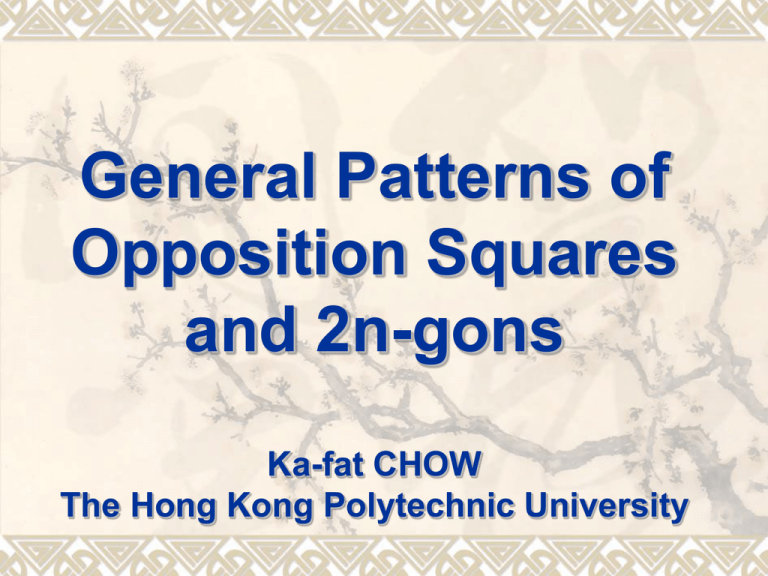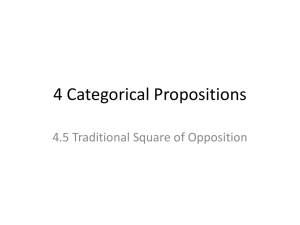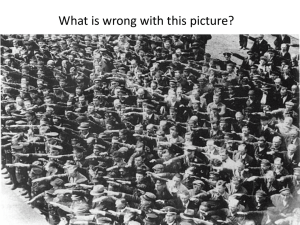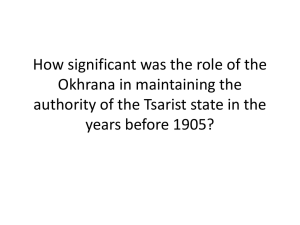General Patterns of Opposition Squares and 2n-gons
advertisement

General Patterns of
Opposition Squares
and 2n-gons
Ka-fat CHOW
The Hong Kong Polytechnic University
General Remarks
Definitions of Opposition Relations:
Subalternate: Unilateral entailment
Contrary: Mutually exclusive but not collectively exhaustive
Subcontrary: Collectively exhaustive but not mutually
exclusive
Contradictory: Both mutually exclusive and collectively
exhaustive
Do not consider inner / outer negations, duality
Adopt a graph-theoretic rather than geometrical view on
the logical figures which will be represented as 2dimensional labeled multidigraphs
General Pattern of Squares of
Opposition (1st Form) – GPSO1
Given 3 non-trivial propositions p, q and r that constitute a
trichotomy (i.e. p, q, r are pairwise mutually exclusive and
collectively exhaustive), we can construct the following
square of opposition (SO):
General Pattern of Squares of
Opposition (2nd Form) – GPSO2
Given 2 non-trivial distinct propositions s and t such that (a)
s t; (b) they constitute a unilateral entailment: s u t, we
can construct the following SO:
GPSO1 GPSO2
Given a SO constructed from GPSO1, then we
have a unilateral entailment: p u (p q) such
that p (p q).
GPSO2 GPSO1
Given a SO constructed from GPSO2, then s, ~t
and (~s t) constitute a trichotomy.
Applications of GPSO1 (i)
Let 50 < n < 100. Then [0, 100 – n), [100 – n, n] and (n,
100] is a tripartition of [0, 100]
NB: Less than (100 – n)% of S is P ≡ More than n% is not
P; At most n% of S is P ≡ At least (100 – n)% of S is not P
Applications of GPSO1 (ii)
In the pre-1789 French Estates General, clergyman,
nobleman, commoner constitute a trichotomy
NB: clergyman nobleman = privileged class; commoner
nobleman = secular class
Applications of GPSO2 (i)
Semiotic Square: given a pair of contrary concepts,
eg. happy and unhappy, x is happy u x is not
unhappy
Applications of GPSO2 (ii)
Scope Dominance (studied by Altman, Ben-Avi,
Peterzil, Winter): Most boys love no girl u No girl
is loved by most boys
Asymmetry of GPSO1
While each of p and r appears as independent
propositions in the two upper corners, q only
appears as parts of two disjunctions in the lower
corners.
Hexagon of Opposition (6O):
Generalizing GPSO1
6 propositions: p, q, r, (p q), (r q), (p r)
Hexagon of Opposition:
Generalizing GPSO2
Apart
from the original unilateral entailment,
s u t, there is an additional unilateral
entailment, s u (s ~t)
6 propositions: s, t, (s ~t), ~s, ~t, (~s t)
General Pattern of 2n-gons of
Opposition (1st Form) – GP2nO1
Given n (n 3) non-trivial propositions p1, p2 … pn that
constitute an n-chotomy (i.e. p1, p2 … pn are collectively
exhaustive and pairwise mutually exclusive), we can
construct the following 2n-gon of opposition (2nO):
General Pattern of 2n-gons of
Opposition (2nd Form) – GP2nO2
Given (n – 1) (n 3) non-trivial distinct propositions s, t1, …
tn–2 such that (a) any two of t1, … tn–2 satisfy the
subcontrary relation; (b) s t1 … tn–2; (c) they constitute
(n – 2) co-antecedent unilateral entailments: s u t1 and …
s u tn–2, then we have an additional unilateral entailment:
s u (s ~t1 … ~tn–2) and we can construct the following
2nO:
GP2nO1 GP2nO2
Given a 2nO constructed from GP2nO1, then (a) any two of (p1 p3
… pn), … (p1 … pn–2 pn) satisfy the subcontrary relation
(b) p1 (p1 p3 … pn) … (p1 … pn–2 pn);
(c) there are (n – 2) co-antecedent unilateral entailments: p1 u (p1
p3 … pn) and … p1 u (p1 … pn–2 pn)
This 2nO also contains an additional unilateral entailment p1 u (p1
p2 … pn–1) whose antecedent is p1 and whose consequent has the
correct form: p1 p2 … pn–1 ≡ p1 ~(p1 p3 … pn) … ~(p1 …
pn–2 pn)
GP2nO2 GP2nO1
Given a 2nO constructed from GP2nO2, then s, ~t1 … ~tn–2, (~s t1
… tn–2) constitute an n-chotomy.
The Notion of Perfection
A 2nO is perfect if the disjunction of all upper-row
propositions ≡ the disjunction of all lower-row propositions
≡ T; otherwise it is imperfect
A 2mO (m < n and m 2) which is a proper subpart of a
perfect 2nO is imperfect
Any SO (i.e. 4O) must be imperfect
An imperfect 2mO may be perfected at different finegrainedness by combining or splitting concepts
Perfection of an Imperfect 2nO (i)
Perfection of an Imperfect 2nO (ii)
2nO is not comprehensive enough
The relation p1 p4 u p1 p2 p4 is missing
The relation between p1 p4 and p2 p4 is not
among one of the Opposition Relations
We need to generalize the definitions of
Opposition Relations
Basic Set Relations (BSR) and
Generalized Opposition Relations (GOR)
15 BSRs
GOR: {<proper
subalternation, proper
superalternation>,
<pre-falsity, postfalsity>, <pre-truth,
post-truth>, <antisubalternation, antisuperalternation>,
proper contrariety,
proper contradiction,
loose relationship,
proper subcontrariety}
2n-gon of Opposition (2nO)
Given p1, p2, p3, p4 that constitute a 4-chotomy, we can construct a 24O based on the GORs
Some Statistics of 24O
GOR
Number of Instances
<proper subalternation, proper superalternation>
36
<pre-falsity, post-falsity>
14
<pre-truth, post-truth>
14
<anti-subalternation, anti-superalternation>
1
proper contrariety
18
proper contradiction
7
loose relationship
12
proper subcontrariety
18
Can we formulate the GP2nO?







